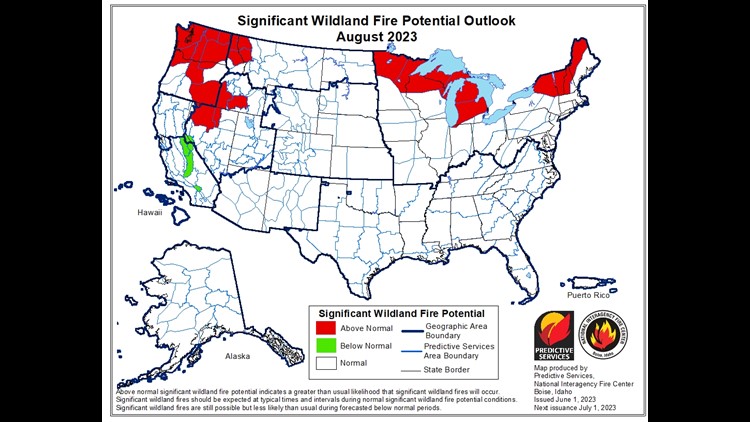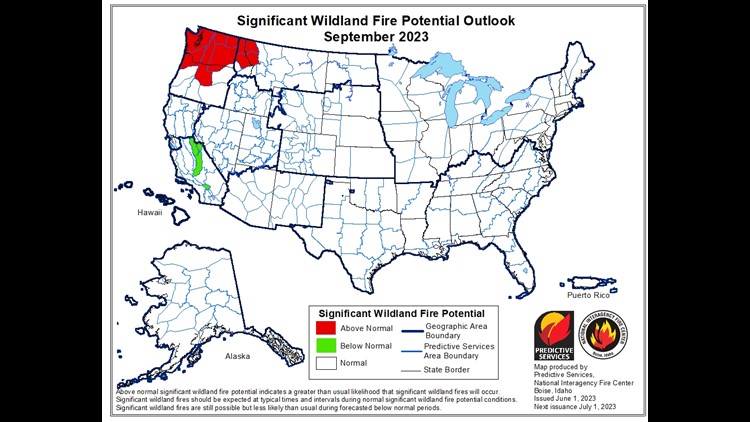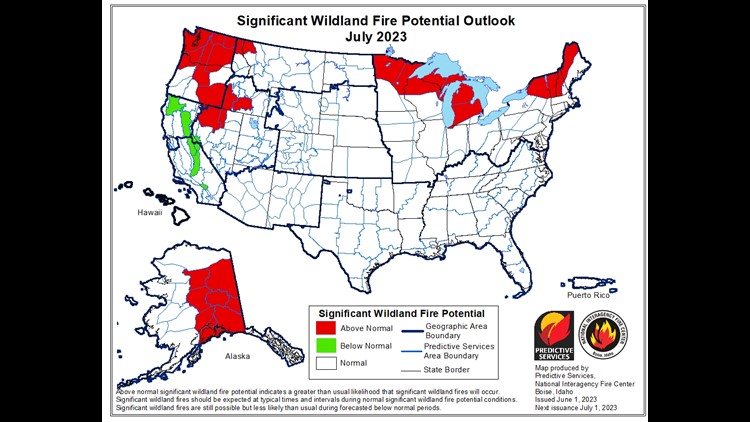WASHINGTON, USA —
After a dry spring, the Pacific Northwest is on alert for high fire risk through the summer and even into the fall.
The Outlook
Images from the National Interagency Coordination Center show the PNW in the “above normal” threshold through September, which indicates a greater than normal likelihood that significant wildland fires will occur.
National Interagency Fire Center outlook summer 2023
According to Washington State Climatologist Nick Bond, this summer is an example of big-picture changes in patterns. He said data shows that in the last few decades, summer precipitation totals are declining statewide. Plus, there are more extremes in the form of wet winters and warm, dry summers.
“That whipsaw, they’ve always happened but to a certain extent, it seems like they’re getting more dramatic now,” said Bond.
Looking forward, models show this trend will continue.
“The models do suggest, our climate models used for projections out into future decades, indicate as a group, wetter winters and drier summers. So that’s going to exaggerate the water cycle with, obviously, floods in time of winter and lack of water in summer,” he added.
The Impact
This change in weather is having a direct impact on wildfires in the state. Bond pointed out that the number of acres burned every year is on the rise in the state of Washington. From 2003 to 2012, the average number of acres burned every year in the state was 1,662,207 acres (the average of all 10 years combined). In the following decade from 2013 to 2022, that number nearly tripled to 4,674,006 acres burned on average every year in that ten-year span.
The Cycle
After a wet winter, vegetation grows. Then, when the heat hits, that vegetation dries out. With extreme rain and extreme heat, that pattern is exacerbated, creating a potentially dangerous flammable situation.
“In different parts of the west, there certainly can be an elevated hazard after a wet winter. That's especially where the grasses and shrubs are the main sources of fuel with enhanced growth there. Then there’s that much more to burn when it dries out in summer,” said Bond.
That’s the current situation in Western Washington. Looking at data from the Seattle Tacoma airport, the first six months of 2022 brought above-average rain. By the end of June, Sea-Tac recorded about 25 inches of rain, well above the around 20 inches that’s normal for that time of year. Immediately after, summer 2022 broke records for how warm and dry it was. Then, winter and spring into 2023 brought below-average rain with about 14 inches of rain recorded by the start of summer, down about six inches compared to normal for that time of year.
The History
Bond also wants to take note of the fact that wildfires have happened in the state of Washington. According to the Department of Natural Resources, the Yacolt Burn of 1902 ravaged Clark, Cowlitz and Skamania counties in southwest Washington in September of 1902. Multiple fires eventually burned almost 239,000 acres and caused 38 deaths. This fire occurred after an extended period of hot and dry weather.
Bond also pointed out that one of the most detrimental factors that can influence fire potential is wind. Major fires are worsened by wind storms, which are harder to predict. Models can suggest temperature and precipitation trends in the short term, but wind events are much more difficult to predict.
The People
Bond said the best tool for people in the Pacific Northwest to use now is preparedness. Homeowners can install roofs that are less prone to fires, create defensible space by clearing brush around any buildings and improve access to property for fire crews should fires start.
While it’s difficult to predict exactly where a fire could start, Bond said the foothills seem to have the highest risk for fires and should be on high alert.
The town of Skykomish, more than 50 miles east of Seattle, is getting familiar with this new reality. The Bolt Creek Fire burned just beyond Skykomish in September of 2022, shutting down Highway 2 and cutting residents off from the outside world for weeks.
Henry Sladek is the mayor of the town and also owns and operates the Cascadia Inn and Cafe. Sladek said the town of about 160 people is accustomed to natural disasters impacting them and cutting them off from the outside world when Highway 2 gets shut down, which can be detrimental for their economy if it’s during their busy tourist season.
The summer months are key for tourism, and while they’re used to bracing for isolation if the highway shuts down, the new obstacle is also preparing for the direct impacts of wildfires in town.
“People don’t really think about that until it happens. What do you pack, what do you take? And realizing it may not be there when it’s all said and done,” said Sladek.
He said he’s working to create a plan for his residents should another fire spark.
The town has banned personal fireworks, plus he’s been in communication with other leaders from neighboring towns to create emergency response plans.
Sladek says they want to be prepared, but they also are thankful to live in such a serene area.
“We enjoy the outdoors and the views you get, even if you have to live with the sometimes isolation and you have to be more prepared,” said Sladek.







